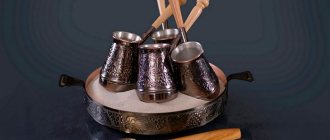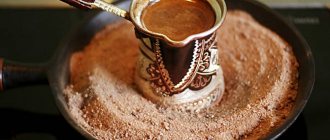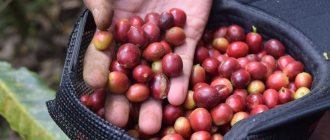During my short career as a barista, my favorite thing to do was brew Turkish coffee on sand. This was a real ritual for me. Next to the thoroughbred Italian coffee machine there was always a heated roaster with sand, which sometimes saved us in the winter cold. A small cezve, a good portion of freshly ground coffee, and for those in the know, a couple of grains of salt are a must. But what fascinated me most was the process itself, when you buried the Turk in the sand in a circular motion, and a pleasant warmth washed over your hand.
I have never liked coffee - I prefer tea. But the job of a barista obliged me to love him, and I did it with complete dedication. In the morning, while preparing the bar, be sure to have a shot of espresso to wake up and get ready for the work day. But he preferred to savor coffee brewed in a Turk. This drink with milk was especially impressive. As it turns out, you can cook it at home just as well. Even on gas, the main thing is that the fire barely burns. As my friend once said: “A samovar is a teapot for the rich...”. His samovar boiled for 20-30 minutes - an unacceptable luxury for a bustling city. Time is money. Proper Turkish coffee is also a drink of the rich.
What does "coffee on the sand" mean?
To prepare the drink, traditional Turkish utensils are used - Turka, also known as cezve or ibrik - with a wide base and a narrow neck, ideally copper or similar alloys. Only instead of a stove, it is heated in a container with hot sand. It is either immersed almost up to the neck, or only shallowly heated at the bottom.
There is special equipment for making coffee on sand, but it is more often used in the professional sphere, although you can also take it for home if you like this particular drink. To just try, you can make do with improvised objects, and it will turn out no worse. Or you can give this set to a coffee lover you know.
There is a special quartz sand for coffee, which can be purchased in special coffee and tea stores, in departments for creativity, for aquariums, decor, and also on classifieds websites. Industrial enterprises sell large volumes, and you only need a little, especially since it is reusable.
Cooking methods
- If you are wondering how to brew coffee with spices, then you should practice this topic separately. When preparing such a drink, you should not overdo it with spices. Grind them into dust, of course, separately from the grains, and add just a little along with sugar and salt. Among the common ways coffee is prepared with spices is by adding pepper or ginger.
- Another way to brew Turkish coffee is to add yolk. The step-by-step procedure is described above, but before pouring the grounds into a cup, the person preparing the drink must beat half the yolk, pour it into the cup and pour over the brewed drink.
- It would be interesting to know how to properly brew Turkish coffee with cognac. The taste is piquant, and the aftertaste mixes the aromas of cognac and coffee. You should take 15 ml of cognac per cup, and also grate half a teaspoon of orange zest.
Benefits of brewing coffee on sand
There are several reasons to try this cooking method once you are interested in it. Maybe you tried coffee in Turkey, or you just like to try new things, in any case, our arguments will further convince you.
Proper heating for better extraction
The main advantage of this cooking method is the uniform heating of the cezve. When you cook on a regular stove, the Turk essentially heats up from the bottom. The walls remain cold longer, and extraction proceeds unevenly. By immersing the cezve up to its neck in hot sand, you warm it up over the entire surface at once. It turns out faster and better quality.
Guaranteed success with the right grind
The second plus is that this way you can achieve that very authentic taste of oriental coffee on sand. For classic Turkish cooking, it is usually recommended to use a coarse grind (but most people take the standard medium grind, as in almost all packs of ground in the store). For “sand” cooking, the finest grinding is used, “to dust”, as is customary in the east. These are just two different drinks, each of which is good in its own way, but we prepare an authentic drink in an ancient way (dating back to the 13th-14th centuries).
Easy to control heating level
The third important factor is the simplicity and convenience of temperature control. It heats up quickly - raise it a little, and immediately, to quickly reach the rise of foam, immerse it “up to your shoulders”. By controlling how deep the Turk is immersed in the sand, you control the temperature, and you do not need to reduce or increase the temperature of the coolant.
The drink prepared in a sand bath turns out to be thick, concentrated, often stronger and more bitter, just as they like in the East.
What not to do when serving a drink
It is important to note that sugar is added during cooking, but not after. You should also not serve any food. The aftertaste should not be blurry, so you can drink coffee as a digestif or as a stand-alone drink. Although no one forbids serving chocolate, Turkish delight, dates.
Turkish coffee should not be flavored with milk or lemon. You can always find other recipes where appropriate. Of course, everyone decides how to drink such a drink individually, but if you don’t adhere to traditions, you won’t get the desired effect.
Note: if you brew coffee in a Turk on the stove, you should make sure that the drink does not boil over, otherwise the process is identical.
What you need to make coffee in a Turk on sand
The recipe is, in general, standard. You can modify it slightly by adding ingredients, but the principle is the same. And for this house you will need only 5 components:
- Coffee. In Turkey they make it from 100% Arabica, because the drink will already be very strong; Robusta is not needed there. Moreover, Arabica beans are tastier and more aromatic. And it should be of the finest grind. You can grind it yourself, buy a ready-made bag in a specialty store, buy coffee by weight and ask for it to be ground as finely as possible.
- Pan. Better is an old one, without Teflon coating, and with high sides, or a large bucket. Ideally, it would be possible to bury the cezve up to the neck. In Turkey, small, portioned dishes are used; it will be more difficult to do this with a large one. In general, there are special frying pans, and perhaps in the future you will want to buy one, but a frying pan is also suitable for starters to try and understand the principle.
- Sand. We have already told you where to buy sand for making coffee, but for the first time you can get by with fine regular sand. Sift it from debris and shells, rinse and heat it so that it is definitely clean.
- Salt. Regular salt, preferably fine, but standard salt will also work, which you mix with sand to speed up heating. For a medium frying pan - three heaped spoons, and so - be guided approximately, there are no clear canons. You can do without salt.
- And, of course, you will need water, and optionally sugar and spices.
Milk is not traditionally added to this drink. In Turkey, they may refuse to serve you milk at all if you order oriental coffee, so as not to spoil the taste of the drink.
Story
On that significant day, the inhabitants of distant Ethiopia rose, as usual, with the first rays of the hot sun. People scattered, some went where - some went to plow the field, some stayed to nurse the children, some began to forge iron. And so, as if with the flap of a firebird’s wing, the impenetrable thickets of the jungle began to glow with a bright fiery flame. But fires in forests in those areas are commonplace, so everyone continued to do their job. But less than an hour had passed before a unique tart aroma seeped between the rows of tired people. They, as if by agreement, abandoned the plow, diapers, unfinished weapons and rushed into the deep forest, at the call of an unforgettable smell. And there, in the loud silence of exotic life, the coffee tree was burning. Its fruits were dried and fried under the influence of high temperature.
So says the legend. They say that it was the residents of that village in the Kaffa region (hence the name of the drink so popular in the modern world) who were the first to start brewing coffee. Now this process has been mechanized and brought literally to automation. But real gourmets know how much tastier and more aromatic coffee is when made with their own hands.
So, let's throw all these clever units out of our heads and brew homemade coffee on the sand. This, at first glance, unusual method of preparation is not only explained logically, but also makes it possible to taste the most delicious coffee, since in this case the cezve (in other words, the Turk) is heated completely, whereas in traditional brewing methods only the bottom of the vessel can be heated. This makes the coffee much more aromatic and stronger, and the foam is thicker and more stable.
How to brew coffee on sand at home
Prepare all the above ingredients in advance, mix clean sand with salt.
- Pour sand into a frying pan and place over high heat. Stir it every 20 seconds to ensure it heats evenly. It is not necessary to time it, just mix often enough and efficiently.
- Grind your coffee if you have beans. You definitely need the finest grind, adjust the grinding settings, usually they are at a medium level, even if the particles seem quite small to you. They should rub like dust between your fingers.
- Pour very cold water into the Turk. You can throw in a piece of ice. Pour coffee at the rate of a well-heaped teaspoon per serving, serving is about 100 ml. If you need sugar and spices, add them at this stage. Stir the contents with a spoon until foam appears.
- Immerse the Turk in the sand, rocking it. At first, you can help yourself with a spoon or spatula. Important: the bottom should never touch the metal of the frying pan; there should be enough sand there. It is advisable to fall asleep "up to your shoulders."
- As soon as the foam begins to rise, take the cezve higher; in the future, immerse it not so deeply. The principle is to bring to a boil 3-4 times and the foam rises, but do not boil and do not allow the foam to escape. If he runs away, carefully collect the sand.
- Pour all the prepared coffee into a cup. The whole point is in this thick, dense foam, which is why it is usually prepared in portioned containers so that everything can be poured out at once: the brown-amber foam, the aromatic viscous liquid, and even the sediment, the thick stuff. This is a must.
- Let the drink sit for about a minute to allow the grounds to settle and taste.
The drink prepared in the Turkish way is not filtered. There must be some sediment left.
Spices for coffee on sand
So, we add sugar immediately to the turk, we do not add milk at all, neither immediately nor in the finished drink. What about the spices? Here is a list of those that go perfectly with this drink and are used by oriental coffee makers (the word “barista” is not very applicable to them):
- Cardamom is a classic, an ideal choice, gives a light lemon-mint shade;
- Cinnamon – just add it really generously;
- Nutmeg – spicy aroma and bright taste;
- Star anise is a very “oriental” spice, so it will come in handy;
- Cloves – will add a slight subtle spiciness and is always appropriate;
- Black pepper - unexpected, but very oriental;
- Allspice or a mixture of peppers, or red - just a little to set off the flavor.
All spices must be crushed. If you grind each batch of coffee before brewing, you can grind it all together. Or pound in a mortar. Or take ready-made ground ones.
Turkish coffee cups
The classic container for drinking coffee is small cups made of Turkish porcelain. Making coffee is a whole ritual for the Turkish people, and beautiful cups are part of this ritual. They are produced in such a way that they retain heat well during leisurely consumption of the drink.
The culture of appreciating coffee contributes to the development of a system of artistic crafts for the manufacture of tools, utensils and utensils for dispensing the drink.
Coffee mugs, trays, paints, portable coffee grinders, boilers, coffee pots, etc. have special artistic value and contribute to the creation of unique products. Offering coffee in exquisite cups is the Ottomans' way of honoring the dignity of those who love coffee.
The Ottoman Empire had a famous proverb, “The memory of a cup of coffee lasts 40 years,” understood as a precious moment where enjoying a cup of coffee with friends will be remembered for a lifetime. This proverb expresses the importance and depth in the Ottoman and modern Turkish culture of hospitality and friendship through coffee.
How to Serve Coffee Made with Sand
For serving, demitasse cups are used: small in volume, with very thick walls. Ideally, they should also be reheated before serving. This will keep the heat longer and allow the drink to open better. It's nice when the foam is almost at the edge, so choose your cups and portions accordingly.
According to Eastern tradition, this drink is always served with a glass of clean, still, cold water. It is drunk (all or partly) before drinking coffee to refresh the taste buds, and possibly wash away saliva (no need to rinse your mouth). This way you can better feel the taste of the drink.
Oriental sweets or small desserts are served with coffee on the sand; the portion of the drink itself is small, so a piece of cake is not the best option if you need to wash it down. Pieces of oriental sweets would be good:
- Baklava;
- Turkish Delight;
- Mini cookies;
- Writing;
- Halva.
Do not stir the finished drink so as not to destroy the foam with a spoon and not raise the grounds.
An interesting bonus from coffee on the sand
Don't finish the last sip; leave about a tablespoon of liquid along with the grounds. Shake the sediment and turn the cup over on a saucer, try to tell fortunes on the coffee grounds. Other types of coffee are not suitable for this, the grind is coarse, and fine dust creates the most interesting patterns. You shouldn’t take this seriously, but you can entertain yourself by ordering coffee on the sand in a cafe, or treating it to someone special at home!
How to drink correctly
In order for the ritual to be observed, it is important to understand how to drink such a long-awaited drink correctly.
- 50 ml cups are best. The cups should be warm; they can be heated in the sand.
- When drinking the fiery liquid, you should drink some water, so serve a glass of cold water.
It is not customary to drink a rich drink in large mugs, just as it is not customary to drink two or three cups in a row, this has its own logic. The caffeine concentration is strong, so you can overload the cardiovascular and nervous system. Then in a cafe you can order yourself tea or a glass of water, or at home you can lie down or do leisurely things.
Algorithm for brewing a drink in the traditions of the East
Turkish coffee is distinguished not only by its unique brewing method. For its preparation, only freshly ground beans of the finest fraction are used, literally like dust. The Arabica variety is considered the best, although Robusta and mixtures are used quite often.
While the sand is heating up, you need to grind the coffee beans very finely.
Using a teaspoon, mix ground coffee with cold water in a Turkish coffee pot. The ratio is 1 cup cold water and 2 teaspoons ground coffee. If you prefer sweet coffee, add sugar at the same time as water. Under no circumstances add sugar at the end, this will spoil the taste of the finished drink.
Place the sand in advance in a thick-walled frying pan and heat it on a gas stove. When the sand has warmed up evenly, immerse the Turk and carefully add until the neck narrows. This way, the sand will warm the Turk from all sides, and allow the coffee grounds to exchange a fragrant bouquet with the water.
The sand should warm the Turk evenly from all sides
When the first bubbles of dark foam appear, remove the Turk from the sand. And after a few minutes, repeat the procedure. Transfer a little fluffy foam into heated coffee cups, set aside the Turk to allow the grounds to settle, and only then pour the drink.
Ginger with turmeric
Coffee with the addition of ground turmeric
Turmeric is the most unique and healthy spice that gives your morning coffee a special aroma and unique taste. Two natural antiseptics - ginger and turmeric - are very popular in eastern countries. This coffee is consumed in hot weather to improve vitality. Organize a coffee ceremony and surprise your friends with your deep knowledge of the culture of the East.
We will need:
- freshly ground coffee - 3 tsp;
- water - 1.5 tbsp;
- turmeric - ¼ tsp;
- fresh chopped ginger - ½ tsp;
- sugar to taste.
Ginger emphasizes the strength of the drink and pleasantly burns the throat, and the aftertaste with a hint of turmeric fills it with vital energy and gives an inexhaustible charge of vivacity.
Cooking process:
- Mix dry ingredients in a pot: coffee, turmeric, sugar.
- Add cold water, mix and immerse the Turk in the heated sand.
- When the foam rises, remove from heat and add chopped ginger.
- Bring to a boil several more times and remove from the sand.
- Wait until the grounds settle and pour into coffee cups.
How to brew chocolate coffee
The cocoa coffee recipe is perhaps the simplest on this list. All you have to do is take your favorite brand of cocoa powder and add it to your freshly ground coffee. When heating the Turk on the sand, you will feel the richness of chocolate mixed with the smell of coffee, combining East and West in one mug.
Cocoa will give coffee a pleasant chocolate taste.
We will need:
- freshly ground coffee - 3 tsp;
- water - 1.5 tbsp;
- cocoa powder - 1.5 tsp;
- sugar to taste.
Cooking process:
- Mix freshly ground coffee and cocoa powder in a Turk, add water and place in heated sand.
- When the foam rises, remove the Turk from the sand and return it back after a few minutes.
- Do the procedure three times and, after settling the grounds, pour into coffee cups.
Moroccan spicy
Moroccan spiced coffee is a traditional oriental drink.
Moroccan spiced coffee is one of the traditional options for preparing the drink of the gods in the East. Its strength and abundance of spicy components are highly valued by the local population.
We will need:
- cinnamon ¼ tsp;
- cardamom ¼ tsp;
- cloves 4 stars;
- freshly ground coffee - 3 tsp;
- purified cold water - 0.2 l;
- sugar to taste.
Brewing process:
- Put cinnamon, cardamom, cloves in a Turk and heat it on hot sand.
- Pour in purified water.
- Immerse the Turk deep into the hot sand and bring to a boil.
- Quickly remove from the sand and after a few minutes repeat the procedure twice.
- Let the thickener settle and pour into heated cups.
Cinnamon inspiration
Save this recipe for a long-awaited weekend and you are guaranteed an incredible start to the day. We don’t promise that it will be productive, because coffee with cinnamon has a relaxing effect, despite the strength of the drink. Cinnamon coffee goes harmoniously with milk and brown sugar.
Goes well with milk and has a relaxing effect
We will need:
- freshly ground coffee - 2 tsp;
- water - 1 tbsp.;
- cinnamon - ¼ tsp;
- sugar to taste.
Brewing process:
- In a Turk, mix coffee with water and place in hot sand.
- When bubbles appear, add half a portion of cinnamon and stir.
- Remove from the sand and repeat the procedure after a few minutes.
- At the end of brewing, add the remaining cinnamon and stir.
- Let it thicken and pour into warmed coffee cups.
Oriental coffee with honey is perhaps the only option that allows you to stir the finished drink after preparation. Nutmeg and honey have natural healing properties, so coffee prepared according to this recipe helps fight colds and increases the body's protective properties.
You can expect a healing effect from this drink
We will need:
- freshly ground coffee - 2 tsp;
- water - 1 tbsp.;
- honey - 1 tsp;
- nutmeg - ½ tsp.
Brewing process:
- Mix nutmeg with coffee and add purified cold water.
- Immerse the Turk in the sand and leave until bubbles appear.
- Leave for a few seconds, then return again to the hot sand.
- Bring to a boil three times and remove the Turk from the sand.
- Add a spoonful of honey and mix well.
- Wait for the grounds to settle and pour into coffee cups.
What equipment can be used
The device with which you can prepare coffee on sand has the unusual name “hovoli”.
What it is? Outwardly, the hovoli often looks like an antique thing, but the designers created the device so that it would be easy for a modern person to operate it.
Typically, a heating element (tubular electric heater) is built into the device, the task of which is to quickly and efficiently heat the sand.
The power regulator allows you to control this process; with its help you can not only select the desired temperature regime of the sand cushion, but also, if necessary, change the intensity of the heat.
Despite all the similarity in technical characteristics, the devices differ in their design, which is the determining factor in the buyer’s choice of device.
It can be inexpensive (budget option - simple design, stainless steel body), belong to the middle price category, or be an exclusive item that only a few people can shell out for.
If you buy an average-priced device, you can opt for products from the Greek brand Johny: brass or copper body, original design, connection to the electrical network.
Mostly restaurateurs purchase such equipment, but private individuals (for use at home) are also quite capable of it.
For example, a Johny AK/8-4 device will cost a little more than 20 thousand rubles. Its weight is 6.5 kg, and its parameters are 290 x 290 x 240 mm.
Devices with an exclusive design are, of course, much more expensive - they are lavishly decorated in an antique style and made of expensive materials.
True, this does not change the essence. In all cases, the device represents a certain platform filled with sand, which begins to heat up when the device is connected to the electrical network.
When the temperature reaches the required level (and this happens in a matter of minutes), the cezve is lowered into it.
The best coffee brewing unit today is one made in Greece..
Among the products of the Greek manufacturer Johny there are devices intended specifically for home use - in them the fryer is placed not on some special stand, but on a stove, electric or gas.
Read about how to brew Turkish coffee on the stove correctly and tasty in this article.
Do you know what the differences are between Robusta and Arabica? Find the answer to your question in this publication.
The rating of coffee machines for home 2021 is presented here.










